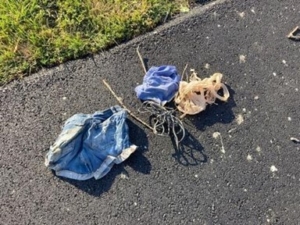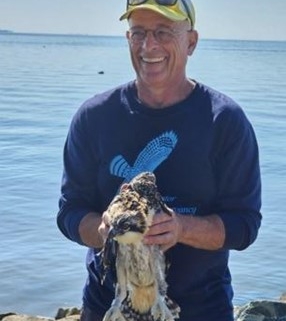A Community Effort: Banding Osprey in Colonial Beach
Cover Photo: Joanie Millward, FMN Peter Mecca Connecting with a raptor.
Article by FMN Peter Mecca – Educator, Scientist and Lifelong learner
As an educator and scientist, I welcome opportunities to interact with all forms of life on Earth. Whether it’s helping to raise trout in Virginia or tagging leatherback turtles in Puerto Rico, my work with wildlife strengthens my passion to learn and care for our natural resources. As a lifelong learner, I believe it’s important to acquire new knowledge and skills, and to use that information to promote a healthy planet for all who share this space.
I am an adjunct biology professor at the University of Maryland’s Global Campus. Formerly, I was a university professor of science education and biology, a science coordinator for Defense Department schools, and a high school science teacher. I hold a BS in Secondary Education-Biology, an MA in Environmental Biology, and a PhD in Curriculum & Instruction, and Ecology. I am also a Virginia Master Naturalist in the Fairfax County Chapter.
While in Colonial Beach, Virginia, this spring, I met Joanie Millward, president of the Virginia Osprey Foundation, and her husband Barry. We discovered a common interest in natural resource conservation and community science. As Joanie and Barry described their involvement with the Virginia Osprey Foundation, I mentioned that I was a naturalist and environmental biologist, and often do volunteer work on events similar to those supported by the foundation. When they extended an invitation to participate in the 3rd Annual Osprey Chick Banding on June 25, I immediately accepted the invitation. Under authority and direction of the U.S. Geological Survey (USGS) and U.S. Fish and Wildlife Service (USFWS), the banding is led and conducted by Ken Smith, a federally permitted raptor bander.
Bird banding is a valuable process in the study and conservation of the approximately 1,270 bird species that exist in the United States. According to the Bird Banding Laboratory at the USGS, bird banding data are useful in scientific research and management, as well as conservation projects. Individual identification of birds allows for study of dispersal and migration, behavior and social structure, life-span and survival rate, reproductive success, and population growth.
Ospreys are abundant in Colonial Beach during the spring and summer seasons. There are more than 50 nesting platforms — human constructed structures — and tree nests in its 2.6-square-mile area. As ospreys return from their wintering grounds in late February and early March, the sky is filled with their presence and songs. Their arrival produces excitement and signals the start of spring and summer in Colonial Beach. Residents share their enthusiasm with one another as they witness these magnificent raptors bringing sticks and other objects to their nests, preparing a place to raise a new clutch of chicks.

Photo: Joanie Millward, Ken Smith and FMN Peter Mecca banding a 4-week-old chick.
On June 25, I joined Joanie, Barry, and Ken on visits to five nests where we banded a total of 12 chicks. Since the nests were high above ground, Todd Dalton, a local resident who works for Dominion Energy and is authorized to use the company bucket truck, was responsible for the removal and return of the chicks to and from the nest. Ken showed the volunteers how to handle each chick. I was lucky to participate twice. As I held a chick, Ken would carefully get a band, supplied to him by USGS with a USFW number, size and attach it to the right leg of the bird. Although the band can be attached to either leg, Ken prefers the right. While Ken did the banding, I securely and safely held the chick while paying attention to its behavior. If the chick were to get anxious, I’d place a covering over its head to block vision. This action helps to calm the bird. After the bird was banded, I handed the chick back to Ken, who placed it into a cloth bag and got ready for the next. An osprey usually has two to three chicks at a time, so we had to tag all before Todd could return them to the nest. Given that the chicks ranged in age from four to six weeks, I was surprised as to how docile they were. They basically let us do our job. The mom, on the other hand, was not happy. She constantly tried to intimidate Todd while he was removing and returning the chicks. Fortunately, the adult osprey stayed out of reach of Todd. Once the chicks were returned, it usually took about 10 to 15 minutes for the adults to return to the nest. I suppose they wanted to make sure the humans were out of the area.

Photo: FMN Peter Mecca, Todd Dalton discovers these items in two nests.
As we went from nest to nest, local residents would come out of their homes and inquire about our work. All expressed sincere interest and thanked us for our efforts. Some of the residents volunteered to hold a chick while Ken administered a band. A Colonial Beach police officer, on patrol, also stopped to volunteer.
I am so thrilled about what I did and what I observed in this town. The osprey banding is an example of community science in action. Residents value osprey and are willing to help protect them. I will continue to assist with banding osprey as well as support the efforts of the Virginia Osprey Foundation. Wherever you are in the Commonwealth, I encourage you to connect and engage with nature. Whether its stream monitoring, stream cleanups or bird banding, value our planet and take action.




